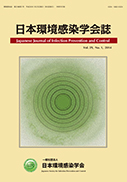Volume 26, Issue 6
Displaying 1-10 of 10 articles from this issue
- |<
- <
- 1
- >
- >|
Original Article
-
Article type: Original Article
2011 Volume 26 Issue 6 Pages 339-344
Published: 2011
Released on J-STAGE: February 03, 2012
Download PDF (419K) -
Article type: Original Article
2011 Volume 26 Issue 6 Pages 345-349
Published: 2011
Released on J-STAGE: February 03, 2012
Download PDF (479K)
Report
-
Article type: Report
2011 Volume 26 Issue 6 Pages 350-358
Published: 2011
Released on J-STAGE: February 03, 2012
Download PDF (2019K) -
Article type: Report
2011 Volume 26 Issue 6 Pages 359-361
Published: 2011
Released on J-STAGE: February 03, 2012
Download PDF (326K) -
Article type: Report
2011 Volume 26 Issue 6 Pages 362-368
Published: 2011
Released on J-STAGE: February 03, 2012
Download PDF (708K) -
Article type: Report
2011 Volume 26 Issue 6 Pages 369-373
Published: 2011
Released on J-STAGE: February 03, 2012
Download PDF (512K) -
Article type: Report
2011 Volume 26 Issue 6 Pages 374-377
Published: 2011
Released on J-STAGE: February 03, 2012
Download PDF (473K) -
Article type: Report
2011 Volume 26 Issue 6 Pages 378-384
Published: 2011
Released on J-STAGE: February 03, 2012
Download PDF (825K) -
Article type: Report
2011 Volume 26 Issue 6 Pages 385-391
Published: 2011
Released on J-STAGE: February 03, 2012
Download PDF (919K) -
Article type: Report
2011 Volume 26 Issue 6 Pages 392-400
Published: 2011
Released on J-STAGE: February 03, 2012
Download PDF (754K)
- |<
- <
- 1
- >
- >|
